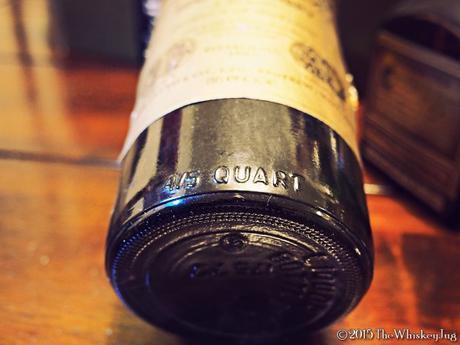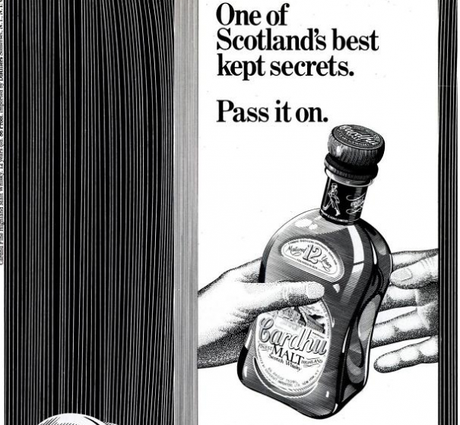
Whether you’re trying to date a bottle of bourbon or determine the relative age of a dusty bottle of Scotch the process for US bottles is pretty much the same; it’s a matter of looking at clues and narrowing down possibilities. Kind of like playing a game of Clue, except with booze.
That doesn’t mean it’s always easy, and figuring out the exact age can be a real hassle, but there are 11 basic clues and resources I use when trying to determine how old a dusty bottle of whiskey is. Below is a run through of each along with some additional resources at the end.
- Start with obvious
- Look for bottle codes
- Government warnings
- UPC codes
- Imperial or Metric?
- Federal tax strips & state tax stamps
- Bonded whiskey = a wealth of info
- Federal Law Forbids Sale or Reuse of this Bottle
- Glass date
- Brand history
- Google Books – Magazines
Start with the obvious

Look for any clues on the bottle itself that’ll pin point it. In the image above we see that it’s commemorating the 200th anniversary of Evan Williams and on the bottle they say the distillery was founded in 1783. Doing some simple math puts this bottle at 1983. Nice and simple.
Look for Bottle Codes

Some bottle codes are easy to decipher while others are not, but if they exist they’re a great place to start. If you can’t decipher them, and can’t find anyone else online who has a clue, reach out the maker if possible and see if they can steer you in the right direction.
Government Warning

You know that big block of text on the back of your whiskey that tells you not to operate machinery or be pregnant while drinking? If it’s not there then your bottle is likely from before 1989 when the Surgeon General’s warning became mandatory.
UPC Codes

Does your dusty bottle of Scotch have a UPC on the back? They fully came into fashion around 1985, but were beginning to popping up in the late 70s and early 80s. If the UPC code is missing you can move the estimated date of the bottle back to at least pre-1985.
Imperial or Metric?

How the liquid in the bottle is measured can also be a clue. From 1981 forward all bottles in the USA started carrying metric (ml, liter, etc.) statements. Before 1979 bottles in the USA were measured using the Imperial system (pint, quart, gallon, etc.). The switch started happening in 1979 and some bottles from 79 / 80 will carry both on the bottle, but could still carry one or the other.
Federal tax strips & state tax stamps

Does your bottle of whiskey have a tax stamp / tax strip? Tax strips are the blue (if exported), green or red strips that go up the side of the neck and over the cap and will either say U.S. Internal Revenue or Bureau of ATF. If it says ATF on the strip then you’re bottle is from 1977 – 1985. If it mentions the IRS then it’s pre-1977 which still covers a lot of time, but fear not we can break it down into smaller chunks thanks to tax strip changes over the years.
- 1934-1944: Weight/Proof Marks on Ends, No “Series” near Eagle’s feet. Upper-left edge reads “US Internal Revenue”
- 1945-1972: Words “Series” and “111″/”112″ added near Eagles feet. Upper-left edge reads “US Internal Revenue”
- 1973-1976: Volume markings removed from ends of Tax Strip. Upper-left edge reads “US Internal Revenue”
- 1977-1983: No Volume markings. No “Series” or “111″/”112″ near Eagle’s feet. Upper-left edge reads “Bureau of ATF”
- In 1982 the words “Tax Paid” and “Distilled Spirits” were removed and replaced with simply “Distilled” and “Spirits” on the bottom of the strips.
- The green Bottled in Bond strips were discontinued starting December 1, 1982.
(details via DrinksPlanet)

Some states also used their own tax stamps which can give clues like the State Treasurer’s name, tax rate, State Secretary’s signature, etc. Most of that info can be looked up online so you can narrow your date range by looking up who was in charge when the tax stamp was used.
Bonded whiskey = a wealth of info
If you’re lucky enough to score a dusty bonded whiskey your job is even easier because the green tax strip will state both the made (distilled) and bottled date. Though if the numbers have faded you can ball-park it by looking at the verbiage on the strip itself.
If it reads: “This bottle has been filled and stamped under the provisions of sections 5008 and 5243 Internal Revenue Code.” then it’s pre-August 1959 because in August of 1959 the sections it refers to changed to 5205 and 5233.
Federal Law Forbids Sale or Reuse of this Bottle
Typically embossed on the bottle itself, though sometimes printed on the label, these words will date your whiskey to sometime between 1932 – 1964.
Glass Date

I always save this for a last resort, but look at the bottom of your bottle. Is there a 2 digit date on the bottom? Likely there is and it could denote when the bottle was made. It does NOT denote when the whiskey was put in the bottle, as some suggest, but possibly when the bottle was made – or even when the mold for the bottle was made. It could also just be a proof number or something from the manufacturer and mean nothing at all in regards to age. Take these with a grain of salt.
Brand History

Is it a brand that’s currently in existence? Reach out and see if anyone at the company can tell you when it’s from. If it’s a style that’s no longer made do a quick Google search to see if you can find out how long it was made for. If it’s a dead distillery look it up and see how long the distillery was around for. Basically I’m telling you to Google it. And speaking of Googling it…
Google Books – Magazines

Another great way to figure out the relative date of your bottle is advertising. Search for your bottle (by name) in Google Books under the magazines. Find ads that depict your bottle and you’ll know roughly when it’s from. Bottle label designs can change over the years and advertising will always depict what the label looked like at that time so consumers could go out and get that exact bottle. You can basically use advertising as a visual history of label changes. https://books.google.com/books/magazines/language/en
Using the info here you should have no problem figuring out at least a ballpark age range for your dusty finds. With a bit of practice you’ll soon have your friends asking you how to date a bottle of whiskey, but if you want to make ‘em “learn the hard way” you can always send them here. Nothing wrong with that.
Cheers!
P.S. if you’re looking for some other great whiskey bottle dating resources give these a peek.
Other Resources
- http://whiskeyid.com/
- http://www.drinksplanet.com/dating-a-bottle-1444.html
- http://www.drinksplanet.com/dating-us-bottles-via-tax-stamps…-1205.html

